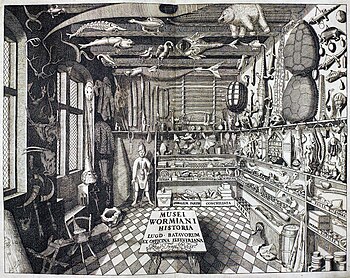Cabinet of Curiosity ::
Cabinet of curiosities
From Wikipedia, the free encyclopedia

"Musei Wormiani Historia", the
frontispiece from the
Museum Wormianum depicting
Ole Worm's cabinet of curiosities.
Cabinets of curiosities (also known as
Kunstkabinett,
Kunstkammer,
Wunderkammer,
Cabinets of Wonder, and
wonder-rooms) were encyclopedic collections of objects whose categorical boundaries were, in
Renaissance Europe, yet to be defined. Modern terminology would categorize the objects included as belonging to
natural history (sometimes faked),
geology,
ethnography,
archaeology, religious or historical
relics, works of art (including
cabinet paintings), and
antiquities. "The Kunstkammer was regarded as a
microcosm
or theater of the world, and a memory theater. The Kunstkammer conveyed
symbolically the patron's control of the world through its indoor,
microscopic reproduction."
[1] Of
Charles I of England's collection, Peter Thomas states succinctly, "The
Kunstkabinett itself was a form of propaganda"
[2]
Besides the most famous, best documented cabinets of rulers and
aristocrats, members of the merchant class and early practitioners of
science in
Europe formed collections that were precursors to
museums.


No comments:
Post a Comment
Note: Only a member of this blog may post a comment.